The
Humans of Mercia
Humans are quite possibly
the most powerful race in the world of Agon, and they are
definitely the most numerous. Their power is concentrated
in the great kingdom of Mercia, which dominates the central
parts of Agon. Mercia is
a realm of knights and castles, and it is a place where
the priesthood wields great power. It is a land where
nobles live in splendid luxury, supported by thralls who
suffer through miserable lives.
Physical description
One reason for the dominant position of the human race
on Agon is their adaptability. In addition to being mentally
resourceful, humans are equipped with a flexible physique,
and genetic material that responds quickly to changing
conditions.
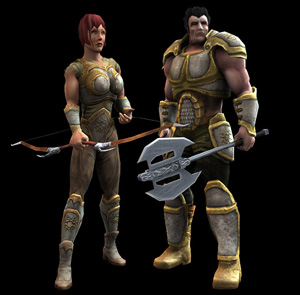 As a result of their genetic flexibility, humans are the
least homogenous of all the races inhabiting Agon. They
vary greatly in height, for instance, with everything
from 215 cm to 155 cm being considered normal. Female
individuals tend to be shorter than males, but exceptions
to this rule are plentiful.
As a result of their genetic flexibility, humans are the
least homogenous of all the races inhabiting Agon. They
vary greatly in height, for instance, with everything
from 215 cm to 155 cm being considered normal. Female
individuals tend to be shorter than males, but exceptions
to this rule are plentiful.
In general, humans are more stoutly
built than the mirdain and alfar, but slighter than orks
and mahirim. However, since the human body is so malleable,
a well-trained warrior can be as muscular as a young ork,
while an untrained individual might be as slight as an
alfar.
The most commonly encountered skin
tones among humans are black, brown, tan and yellow. Individuals
with reddish or completely white skin are rare, but not
unseen. Brown and blue eyes are the most common, while
green, grey or red irises are more unusual.
Human hair can be brown, black, yellow,
white or red, and its texture varies just as greatly,
from curly or dreadlocked to thin and straight. Human
hair grows quickly, and individuals tend to change their
hairstyle quite frequently.
Weapons and equipment
In the kingdom of Mercia, clothes reveal an individual's
position within a strictly hierarchical society.
Nobles and rich freemen wear colourful,
expensive clothes made from the finest fabrics. Fashion
changes continuously and erratically, often dictated by
the preferences of the court at Sanguine. Rich Mercians
spend huge sums on clothes, since they are important indicators
of wealth and status.
A high percentage of Mercians are
unfree thralls, and members of this class are not allowed
to wear colourful garments. If a thrall wears a many-coloured
outfit, or clothes made from expensive fabrics, it is
considered an act of defiance against the local lord.
The priesthood of Morgaine wear free-flowing
robes. Their clothes tend to be all white, since this
colour symbolises devotion to the goddess.
Weapons
Human warriors tend to be multi-talented and deadly with
a number of different weapons. They are at less of a disadvantage
than other races when wielding weapons that are new to
them, and they master these new weapons quickly.
Swords are the most commonly seen
weapons, followed by battleaxes, pikes of various kinds,
and warhammers. The longbow is the preferred ranged weapon,
but the crossbow is also common.
The humans of the kingdom of Mercia
are masters of mounted combat. When fighting on horseback,
Mercians often wield lances when charging, and swords
or morningstars when in melee combat. Morningstars are
slow, but deliver devastating blows when swung from horseback
by skilled wielders.
Armour
Human armour is second only to that of the dwarves in
solidity, and it is much lighter than the fruit of Dvergheim's
forges. The strongest human warriors tend to wear full
body platemail, sacrificing mobility for defense.
The body-shaped field plate armour,
which many humans prefer, offers even more protection
than an ordinary full plate, and is even heavier. The
field plate consists of dozens of parts of varying size
that are assembled each time the suit is worn. The formidable
field plate is cumbersome indeed, and it most commonly
used by soldiers on horseback.
Though the knight in heavy armour
is their warrior ideal, Mercians are nothing if not flexible,
and many individuals prefer lighter armour, often in order
to facilitate more subtle fighting techniques. Chainmail
is common, as is banded mail and splint mail. Humans who
rely more on magic than on swordfighting prefer chain
shirts or leather armour.
Rich Mercians tend to own at least
two suits of armour; one for use in combat, the other
for use on festive occasions. The festive armour is often
more impressive looking than effective in stopping blows,
and is commonly decorated with – at least –
a finely wrought family crest or clan symbol.
The warhorse
The most adept Mercian horsemen ride formidable warhorses
into combat. These are exceptionally sturdy beasts, which
are taller and more muscle-bound than even the heaviest
draught horse. Warhorses never panic, and fight on despite
life-threatening injuries.
Warhorses are clad in light steel
armour called barding, which protects their flanks against
injury. They can be commanded to attack enemies, and their
front hooves are commonly steel-clad, in order to increase
the damage inflicted.
Society of Mercia
The Kingdom of Mercia is a deeply hierarchical realm,
where all power and affluence rests in the hands of a
privileged minority. A king sits at the pinnacle of the
pyramid of society, and under his auspices, a small class
of nobles rule their fiefdoms with absolute authority.
These nobles live lives of luxury, concentrating on the
twin obsessions of Mercian society: warfare and courtly
romance.
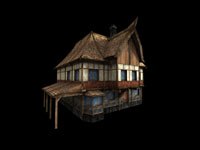 Beneath
the nobles in rank, are a much more varied class of free
men and women. The members of this class include landowners,
independent farmers, merchants, and craftsmen. The level
of wealth and influence varies greatly among the freemen,
but they have one thing in common: As long as they pay
their taxes to local lords and the crown, they are free
to move about and conduct business as they please. Failure
to pay taxes, or obey Mercia's laws, may result in the
removal of freedom, and induction into the ranks of the
thralls. Beneath
the nobles in rank, are a much more varied class of free
men and women. The members of this class include landowners,
independent farmers, merchants, and craftsmen. The level
of wealth and influence varies greatly among the freemen,
but they have one thing in common: As long as they pay
their taxes to local lords and the crown, they are free
to move about and conduct business as they please. Failure
to pay taxes, or obey Mercia's laws, may result in the
removal of freedom, and induction into the ranks of the
thralls.
All thralls are the property of their
respective lords. These people are born into lifelong
servitude, a fate that their children will inherit after
them. Thralls may not move without their lord's leave,
and are obligated to do whatever work he assigns to them.
Most thralls live in rural villages, where they work the
lord's land and farm small plots where they grow subsistence
crops.
The majority of Mercian thralls belong
to the racial group known as the Imric. These are the
descendants of the old Chaldeans, who have dwelled on
the continent of Agon since time immemorial. However,
their culture fell into a long decline, and finally, approximately
two centuries ago, they were conquered by the Mercians
from the eastern isle of Lyonesse.
While some intermarriage has occurred,
the Mercians generally keep themselves separate, and function
as a ruling class in the kingdom. No Imric is allowed
to carry the titles of knight or lord, or to serve in
the priesthood of Morgaine. There are, however, quite
a few – and steadily more - Imric among the free
craftsmen and merchants of Mercia’s cities.
The court at Sanguine
The capital of Mercia is the largest and most populous
city in all of Agon. Here, throngs of poor freemen live
within the same city walls as well-to-do craftsmen and
the king’s court. Sanguine is a bustling, ever-changing
and vibrant city, which is home to opulent wealth as well
as desperate poverty.
In the heart of Sanguine lies a magnificent
castle. Here, King Henry IV resides, with his wife, two
children, and a large entourage of courtiers and knights.
The sacred city
Far to the north, and far from Sanguine in attitude as
well as distance, lies the city of Dalriada, which is
the religious capital of Mercia. From here, the Morganic
priesthood run their powerful organisation, and many regard
this as the true centre of power in the kingdom.
Dalriada is a town of simplicity
and stark beauty, and it has none of the crowdedness or
architectural extravagance of the temporal capital. Here,
houses are simple, and laid out in well-ordered patterns
around a central cathedral.
This cathedral, called Our Lady of
Light, is the very heart of the Morganic faith. It is
an enormous, many-domed structure made out of white stone
and crystal. Surrounding it are neat gardens and concentric,
artificial waterways crossed by a chain of arched bridges.
Dalriada is considered a holy city,
and its highest authority is not the king, but the Lightbringer
of Morgaine, who resides in the cathedral. Gaunt Castle,
which serves as the headquarters of the White Order, overlooks
Dalriada from the east.
The Mercian army
The roads and borders of Mercia are watched over by its
army. Its fortresses stand along the borders with Mirendil
and Morak, and its many guardhouses guard the King’s
Roads that connect the regions of the land. While the
majority of Mercian army bases stand along the borders,
its headquarters is the enormous Citadel of the Sun, which
lies near Sanguine.
Throughout the history of Mercia,
the generals of the army have vied for power with the
priests of the church. During the long and bloody Wars
of Allegiance, the army supported the king’s claim
to supremacy, while the church raised its own armies,
and fought the king to a standstill. In the years following
the final truce, the church armies have evolved into the
White Order, which stands firm against further encroachments
by the temporal powers.
Due to corruption among army officers,
the White Order recently took over city guard duties in
the capital. Many soldiers whisper that the officers were
innocent, and that the evidence of their alleged crimes
was fabricated by the ambitious high priest of Sanguine,
Verana.
Footsoldiers in the army wear chainmail and wield longswords.
They use white tabards and medium-sized shields adorned
with the golden Lion of Malregard, the ancient symbol
of Mercia’s royal house.
One fifth of all soldiers are archers
trained in the use of the longbow. Archers carry longswords,
which they draw when forced into melee combat. The officers
of the army wear plate mail and use large tower shields.
Their tabards are royal blue instead of white.
The army’s cavalrymen wear
banded mail and wield wooden lances, which they replace
between battles. In close combat, they draw longswords.
Cavalry troops are frequently seen patrolling the King’s
Roads.
A brief history of Mercia
Slightly more than two centuries ago, explorers from the
island state of Lyonesse arrived on Agon. According to
ancient legends, an advanced people from the west once
visited Lyonesse, and those visitors had brought magnificent
gifts, like the secrets of mathematics and writing.
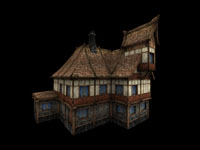 Upon
landing in Mercia, on Agon’s southeastern coast,
the explorers from Lyonesse found only the ruins of the
“prosperous and peaceful land” that their
writings told about. Moss-grown structures and crumbled
statues were all that remained of the culture that had
sparked civilization on Lyonesse. Upon
landing in Mercia, on Agon’s southeastern coast,
the explorers from Lyonesse found only the ruins of the
“prosperous and peaceful land” that their
writings told about. Moss-grown structures and crumbled
statues were all that remained of the culture that had
sparked civilization on Lyonesse.
In its place, they found a simple
people called the Imric, who had little technology, and
lived in scattered villages ruled by tribal chieftains.
The Mercians were dismayed by what they found, and upon
returning to their home in the eastern ocean, they concluded
that the fabled western civilization had fallen into chaos.
Only a few decades later, however,
their own homeland was rocked by great upheavals.
For centuries, Lyonesse had been
a theocracy, ruled by clerics of Morgaine, and protected
by a class of warrior nobles. But countless costly wars
against the chaos forces had made the theocracy unpopular,
and many saw the priests as viciously single-minded in
their pursuit of a society bathed in the light of Morgaine.
When the landed nobles of Lyonesse
rose in revolt, they quickly gained the support of the
general populace. Rampaging mobs plundered monasteries
and chased the hated priests out of their communities.
The instigating nobles chose a king from among their own
ranks, and put him above the leaders of the church.
As she realised that Lyonesse was
lost to the forces of chaos, Morgaine appeared before
the leaders of her faith. She bid them build ships and
set sail for the newly rediscovered land, where they would
set up a holy land among the savages.
A famous knight and noble, Sir John,
Duke of Malregard, led the exodus. After soundly defeating
a hastily assembled army of Agon natives, he founded the
capital of Sanguine, and declared himself the first king
of a new kingdom, Mercia.
At first, Mercia only encompassed
the lands immediately surrounding Sanguine. In the following
years, however, King John and his sons, John II and Robert
I, steadily expanded the kingdom. Though vastly outnumbered
on countless occasions, their technological, organisational
and tactical superiority gave the Mercians the upper hand.
They also found it easy to play native chieftains against
each other, patiently conquering the human lands on Agon
piece by piece.
Seventy years after the invasion,
the majority of human lands were in the hands of the Mercians.
Finally, the remaining native chieftains were able to
unite under a single High King, called Aur the Bold. After
first winning several spectacular victories, Hugh was
crushed by King Robert I at the battle of Dalriada. The
remaining native chieftains now swore fealty to Robert,
and their lands were put under the overlordship of Mercians.
The kingdom of Mercia finally stretched
from the swamps of Morak to the wastes of Nagast. A majestic
cathedral was built at the site of the final victory,
and the king immediately started planning military campaigns
against Mercia’s evil neighbours. But internal trouble
would halt these initiatives before they came to fruition.
Meanwhile, in Lyonesse, the Morganic
faith lay fatally wounded. Other gods rose to prominence,
and in time the worship of the Lady faded. Several decades
passed in relative peace and prosperity.
Then the volcanic forces, which had
spawned the island, turned against it. With little warning,
a large but long dormant volcano exploded, in a blast
that blew half the island away, and covered the rest in
lava and ashes. With a sudden blow, nature had annihilated
the populous and prosperous land of Lyonesse. Today, ash-covered
ruins on scattered islands are all that remains.
The Wars of Allegiance
King John I. of Mercia was a devout worshipper of Morgaine,
and every battle he fought on Agon was dedicated to shining
her light in the darkness. But he did not think it wise
to let Morgaine’s priesthood wield as much power
in Mercia as they had in Lyonesse. In short, King John
wanted to establish a royal dynasty that could counterbalance
the influence of the Morganic church. He made all nobles
swear supreme allegiance to him and his heirs, instead
of to the Lightbringer, as was customary, and tried to
ensure that Mercia’s army would remain under the
control of its kings.
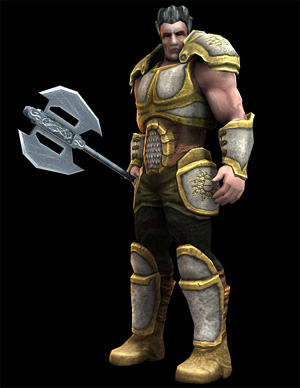 When
the wars against the natives were over, the church started
vigorously opposing this policy. They saw the influence
of Chaos in the movement away from church superiority,
and finally called for all knights and nobles to swear
allegiance to the Lightbringer, and to renounce their
supreme allegiance to the king. When
the wars against the natives were over, the church started
vigorously opposing this policy. They saw the influence
of Chaos in the movement away from church superiority,
and finally called for all knights and nobles to swear
allegiance to the Lightbringer, and to renounce their
supreme allegiance to the king.
A long and bloody civil war followed,
in which the loyalist and clerical forces fought each
other to a standstill. The battle raged for years, with
neither side being able to break the deadlock. Then the
legendary orkish warlord Yrrak the Vile seized his opportunity,
and laid waste to large parts of northern Mercia. However,
the Mercians finally united against the common enemy,
and narrowly defeated Yrrak.
After more than a decade of uninterrupted
warfare, Mercia lay in ruins. King John IV and the Lightbringer
reached an agreement that included the following conditions:
The first allegiance of all Mercian landed nobles should
be to the king. Knights who do not own land, however,
are free to choose where their prime allegiance lies.
The king retains control of the army, but the church is
free to administer its own army outside the jurisdictions
of the crown.
Furthermore, the church is retained
full authority over the holy city of Dalriada and its
environs. The church promptly expanded and fortified Dalriada,
then moved its administration there permanently.
Since then, a state of truce has
existed in Mercia. The power of church and crown have
waxed and waned with the relative strength of Lightbringers
and kings. The reigning king, Henry IV, is weak indeed,
and the same could be said for the present Lightbringer,
the aging Sylvain of Archos. Many speculate what will
happen if the young and ambitious High Priest of Sanguine,
Verana, succeeds Sylvain while Henry still reigns.
Geography
Rolling hills and deep, verdant forests dominate Mercia.
In the kingdom’s central and northern regions, gentle
rivers meander between soft hills, while villages and
castles stand on vantage points. Large flocks of sheep
and cattle graze on hillsides.
The kingdom’s forests are renowned
for their beauty. Sunlight filters down through light
foliage, and small rivers flow through green-clad forest
floors. The Mercian forests are home to a rich and diverse
fauna, while colourful plantlife is supremely plentiful
on sun-filled natural clearings.
In the kingdom’s eastern and
southeastern parts, the soil is exceptionally rich. This
region is considered to have the best farmland in all
of Agon, and it is heavily cultivated. This is a land
of large, walled farmsteads, well-kept roads, and endless
fields of cereal crops.
The river Eanna runs through this
fertile region, and along its banks rose Agon’s
first civilization. The ruins of the once-mighty Chaldean
cities [See A brief history] still stand, weather-beaten
and surrounded by heavily tilled farmlands.
Religion and magic
Officially, Mercians are monotheistic worshippers of the
goddess Morgaine. In thruth, however, the rift between
thralls and free men, between Imric and Mercian, reaches
into the religious sphere. Hidden from the eyes of their
Mercian masters, many Imric thralls worship a pantheon
of older gods.
According to Mercian cosmology, it
was Morgaine who wrought order out of primordial chaos,
and who shone light upon a darkness in which only evil
creatures thrived. She is called the Lady of Light, and
Mercians believe she is engaged in an eternal war with
the forces of darkness and chaos.
Worshippers of Morgaine see it as
their duty to aid the Lady in her struggle. They fight
the armies of chaos, and seek to spread the influence
of their goddess in foreign lands.
Morgaine appears as a tall, pale
woman with long, blond hair and strikingly stern facial
features. She walks barefoot in flowing white robes, wielding
an ashwood staff, and wearing a silver circlet adorned
with a single, azure gemstone.
Originally, Morgaine was worshipped
on the eastern island of Lyonesse, where Mercian culture
originated.
The White Order
Of the Mercian knightly orders, The White Order is the
most powerful. They are the military arm of the Church
of Morgaine, and enforcers of the decrees of her priesthood.
In practice, the Order functions as a religious police
force, who fight the forces of chaos, and who seek out
and destroy worshippers of the old gods.
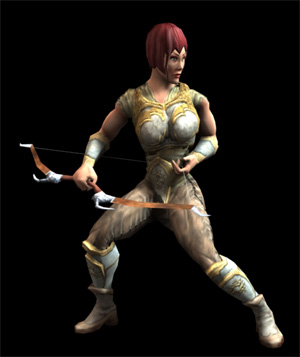 The
leaders of the White Order are answerable only to the
Lightbringer of Morgaine. No local lords, judges, or temporal
knights, are allowed to interfere with the Order's doings.
Its seat of operations is Gaunt Castle in Dalriada, which
was built to protect Our Lady of Light, the most sacred
of Mercian cathedrals. The
leaders of the White Order are answerable only to the
Lightbringer of Morgaine. No local lords, judges, or temporal
knights, are allowed to interfere with the Order's doings.
Its seat of operations is Gaunt Castle in Dalriada, which
was built to protect Our Lady of Light, the most sacred
of Mercian cathedrals.
Five years ago the White Order was
given the task of policing the streets of Mercia’s
capital, Sanguine. The Order has constructed a military
complex just outside Sanguine, and using this impressive
stronghold as a base of operations, it has brought order
to the streets of Sanguine. Some complain that the methods
they use are overly harsh, and that many minor lawbreakers
languishing in the Orders dungeons should be released.
The symbol of the Order is a single
white rose in full bloom, usually depicted against a black
background.
The Order of Malregard
Founded by the first king of Mercia and named after its
ruling dynasty, this is the second most powerful knightly
order in the kingdom. This Order tends to recruit the
finest officers of the regular army, but it has been known
to accept experienced adventurers as well. Traditionally,
the Malregard knights tend to oppose the most extreme
policies of the church and the White Order, and it is
seen as a stabilising force in Mercian society.
The Order of Malregard is fiercely
loyal to the king and his generals. Its symbol is a red
Lion of Malregard wielding an axe.
The Knights of Malregard wear
extremely heavy plate mail, and use silver lances resembling
those used by the Order of the Gryphon. Upon engaging
in melee combat, the knights draw large morningstars.
|

